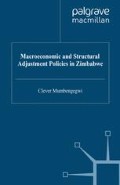Abstract
This chapter seeks to analyze and, in the process, provide an explanation for Zimbabwe’s macroeconomic policies and performance during the period of the economic structural adjustment program (ESAP) which has been being implemented since 1991. In order to appreciate the problems that faced Zimbabwe’s black majority government soon after it achieved independence in 1980 and the economic policies pursued during the ESAP period, it is important to understand the sequence of events, especially the economic policies and strategies pursued prior to the attainment of independence. Firstly, successive settler colonial regimes had culminated in the Unilateral Declaration of Independence (UDI) in 1965 by the then Prime Minister, Ian Smith. This was followed by the imposition of economic sanctions by the British government, with the support of the United Nations, which forced the rebel white colony of Rhodesia to pursue inward-looking policies that were supported by a panoply of controls over the economy. This ushered in a phase of economic development characterized by intensive import-substituting industrialization, accompanied by expansion in agriculture, mining and service sectors. The first decade of UDI experienced rapid growth of both GDP and employment – in excess of 7 and 3.8 per cent respectively. The manufacturing sector expanded its share in GDP from 19.3 per cent in 1965 to 23.7 per cent in 1974 (see Table 2.1).
Access this chapter
Tax calculation will be finalised at checkout
Purchases are for personal use only
Preview
Unable to display preview. Download preview PDF.
References
Davies, Rob (1996) ‘The budget deficit in Zimbabwe’, paper prepared for a National Seminar on Adjustment, Employment and Labour Market Institutions in Zimbabwe, International Labour Organization;, 30 July.
Fine, Ben(1998) ‘Endogenous growth theory: a critical assessment’, SOAS Working Paper Series No. 80, School of Oriental and African Studies, University of London.
Fischer, Stanley and Easterly, William (1990) ‘The economics of the government budget constraint’, The World Bank Research Observer, vol. 5, no. 2, July, pp. 127–42.
Government of Zimbabwe (1998) ZIMPREST (Zimbabwe Program for Economic and Social Transformation 1996–2000). Harare: Government Printer, February.
International Monetary Fund (1998a) ‘The external evaluation of the enhanced structural adjustment facility, report by a group of independent experts’, IMF, March.
International Monetary Fund (1998b) ‘Distilling the lessons from the ESAF reviews’, IMF, July.
Ito, Takatoshi (1998) ‘What can developing countries learn from East Asian economic growth?’, in B. Pleskovic and J. E. Stiglitz (eds), Annual World Bank Conference on Development Economics 1997. Washington DC: World Bank, April, pp. 181–247.
Penrose, Perran, Laurence Harris, Gerald Bloom, Rob Davies, Peter Robinson and Sam McPherson (1997) Evaluation of the EU’s Structural Adjustment Support Program in Zimbabwe, for the Commission of the European Communities, Cambridge, July.
Robinson, Peter (1997) ‘Application of the systems approach to Zimbabwe’, in Tom Yanagihara and Susumu Sambommatsu (eds), East Asian Development Experience: Economic System Approach and its Applicability. Tokyo: Institute of Developing Economies.
Stiglitz, Joseph E. (1996) ‘Some lessons from the East Asian Miracle’, World Bank Research Observer, vol. 11, no. 2, August, pp. 151–77.
Stiglitz, Joseph E. (1998) ‘More instruments and broader goals: moving toward the post Washington Consensus’, WIDER Annual Lectures, United Nations University World Institute for Development Economics Research, Helsinki, January.
World Bank (1996) Zimbabwe: Fiscal Management Review, vol. 1, Macro, Industry and Finance Division, Southern Africa Department, June.
Government of Zimbabwe (1991) Zimbabwe: a Framework for Economic Reform (1991–95). Harare: Government Printer, January.
ZIMCONSULT (1996) ‘Water pricing options and implications’, report for Steering Group of Water Resources Management Strategy, Harare, May.
ZIMCONSULT (1997) ‘The relationship between economic and physical planning in Zimbabwe: the spatial implications of medium and long-term economic policies, and positive planning responses’, Department of Physical Planning, Harare, April.
Editor information
Editors and Affiliations
Copyright information
© 2002 Palgrave Macmillan, a division of Macmillan Publishers Limited
About this chapter
Cite this chapter
Robinson, P. (2002). Macroeconomic Performance under the Economic Structural Adjustment Program: an Essay on Iatrogenic Effects. In: Mumbengegwi, C. (eds) Macroeconomic and Structural Adjustment Policies in Zimbabwe. International Political Economy Series. Palgrave Macmillan, London. https://doi.org/10.1057/9780230391048_2
Download citation
DOI: https://doi.org/10.1057/9780230391048_2
Publisher Name: Palgrave Macmillan, London
Print ISBN: 978-1-349-42137-4
Online ISBN: 978-0-230-39104-8
eBook Packages: Palgrave Economics & Finance CollectionEconomics and Finance (R0)

